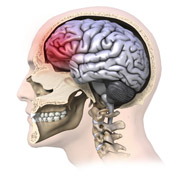Research and Innovation, UNL Office of

Center for Brain, Biology, and Behavior: Faculty Publications
Document Type
Article
Date of this Version
6-4-2019
Abstract
Context: Chronic ankle instability (CAI) is characterized by repetitive ankle sprains and perceived instability. Whereas the underlying cause of CAI is disputed, alterations in cortical motor functioning may contribute to the perceived dysfunction.
Objective: To assess differences in cortical activity during single-limb stance among control, coper, and CAI groups.
Design: Cross-sectional study.
Setting: Biomechanics laboratory.
Patients or Other Participants: A total of 31 individuals (10 men, 21 women; age = 22.3 ± 2.4 years, height = 169.6 ± 9.7 cm, mass = 70.6 ± 11.6 kg), who were classified into control (n = 13), coper (n = 7), and CAI (n = 11) groups participated in this study.
Intervention(s): Participants performed single-limb stance on a force platform for 60 seconds while wearing a 24-channel functional near-infrared spectroscopy system. Oxyhemoglobin (HbO2) changes in the supplementary motor area (SMA), precentral gyrus, postcentral gyrus, and superior parietal lobe were measured.
Main Outcome Measure(s): Differences in averages and standard deviations of HbO2 were assessed across groups. In the CAI group, correlations were analyzed between measures of cortical activation and Cumberland Ankle Instability Tool (CAIT) scores.
Results: No differences in average HbO2 were present for any cortical areas. We observed differences in the standard deviation for the SMA across groups; specifically, the CAI group demonstrated greater variability than the control (r = 0.395, P = .02; 95% confidence interval = 0.34, 0.67) and coper (r = 0.38, P = .04; 95% confidence interval = −0.05, 0.69) groups. We demonstrated a strong correlation that was significant in the CAI group between the CAIT score and the average HbO2 of the precentral gyrus (ρ = 0.64, P = .02) and a strong correlation that was not significant between the CAIT score and the average HbO2 of the SMA (ρ = 0.52, P = .06).
Conclusions: The CAI group displayed large differences in SMA cortical-activation variability. Greater variations in cortical activation may be necessary for similar static postural-control outcomes among individuals with CAI. Consequently, variations in cortical activation for these areas provide evidence for an altered neural mechanism of postural control among populations with CAI.
Included in
Behavior and Behavior Mechanisms Commons, Nervous System Commons, Other Analytical, Diagnostic and Therapeutic Techniques and Equipment Commons, Other Neuroscience and Neurobiology Commons, Other Psychiatry and Psychology Commons, Rehabilitation and Therapy Commons, Sports Sciences Commons


Comments
(c) by the National Athletic Trainers’ Association, Inc. Used by permission.